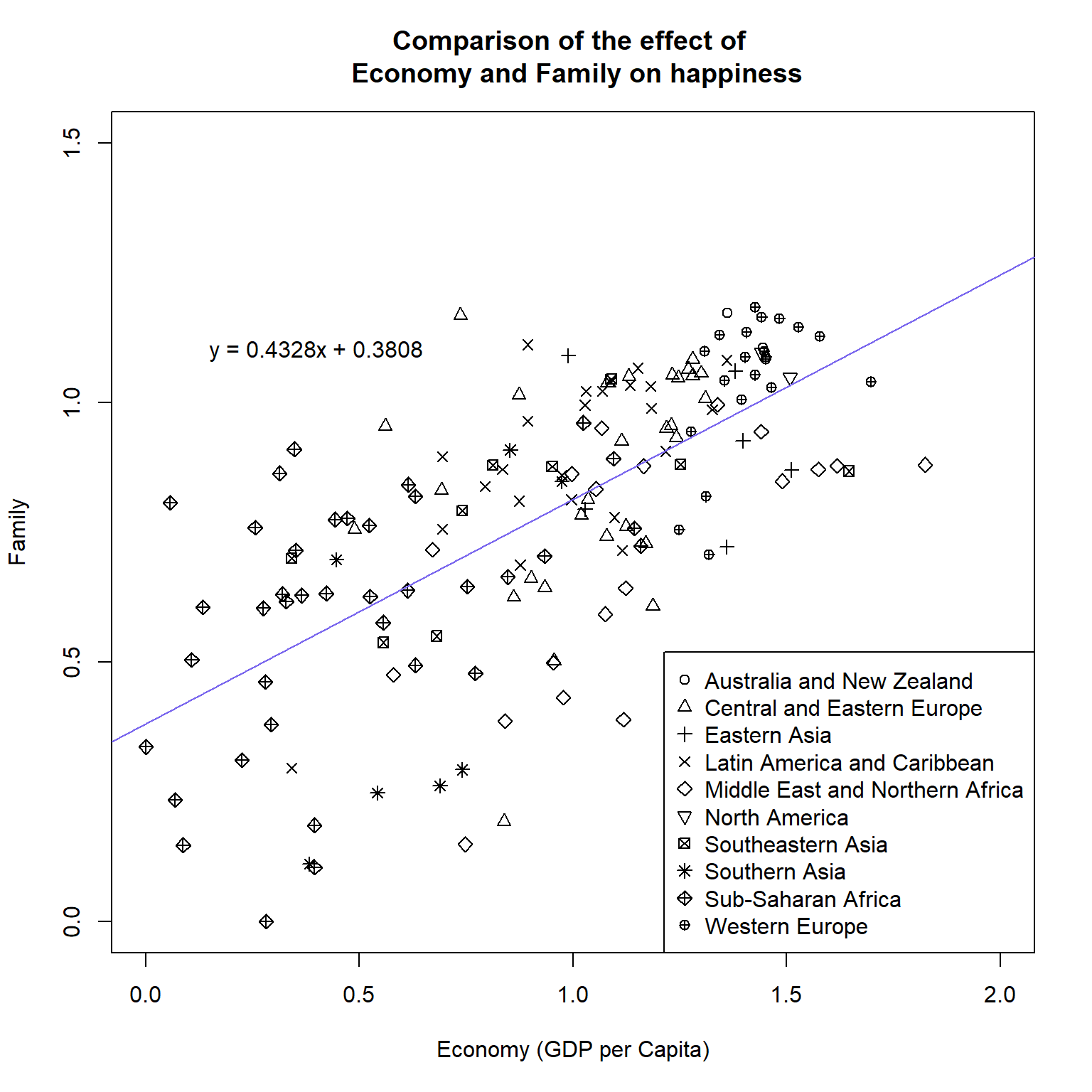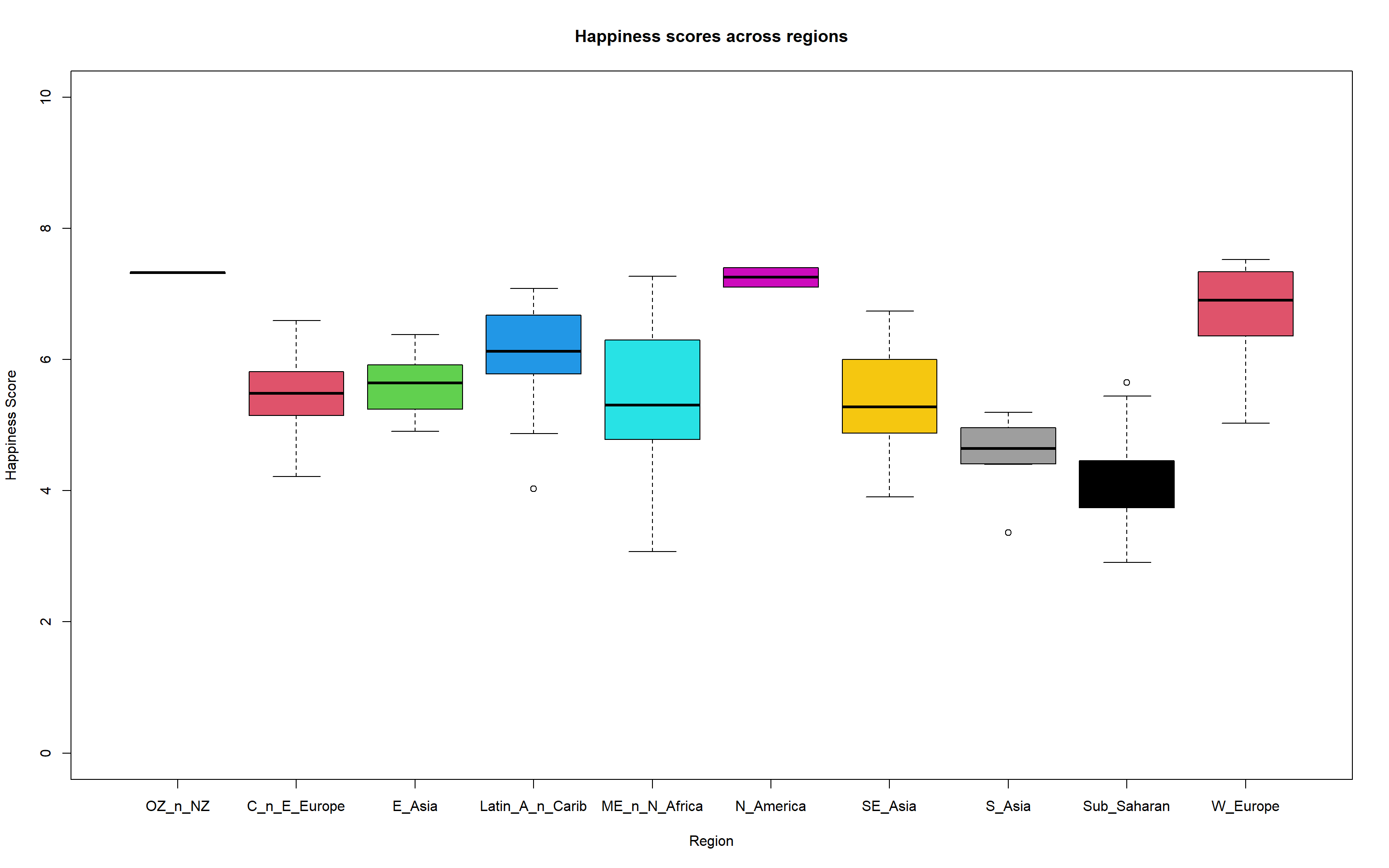Chapter 19 Stats solutions
19.1 World happiness report solutions

- Read in the file
happy_df <- read.csv("Chapter_17-18/world_happiness_report_2016.csv",
check.names = FALSE,
stringsAsFactors = TRUE,
sep = ","
)- Answer the following questions using the output from one function:
## Country Region Happiness Rank Happiness Score
## Afghanistan: 1 Sub-Saharan Africa :38 Min. : 1.00 Min. :2.905
## Albania : 1 Central and Eastern Europe :29 1st Qu.: 40.00 1st Qu.:4.404
## Algeria : 1 Latin America and Caribbean :24 Median : 79.00 Median :5.314
## Angola : 1 Western Europe :21 Mean : 78.98 Mean :5.382
## Argentina : 1 Middle East and Northern Africa:19 3rd Qu.:118.00 3rd Qu.:6.269
## Armenia : 1 Southeastern Asia : 9 Max. :157.00 Max. :7.526
## (Other) :151 (Other) :17
## Lower Confidence Interval Upper Confidence Interval Economy (GDP per Capita) Family
## Min. :2.732 Min. :3.078 Min. :0.0000 Min. :0.0000
## 1st Qu.:4.327 1st Qu.:4.465 1st Qu.:0.6702 1st Qu.:0.6418
## Median :5.237 Median :5.419 Median :1.0278 Median :0.8414
## Mean :5.282 Mean :5.482 Mean :0.9539 Mean :0.7936
## 3rd Qu.:6.154 3rd Qu.:6.434 3rd Qu.:1.2796 3rd Qu.:1.0215
## Max. :7.460 Max. :7.669 Max. :1.8243 Max. :1.1833
##
## Health (Life Expectancy) Freedom Trust (Government Corruption) Generosity
## Min. :0.0000 Min. :0.0000 Min. :0.00000 Min. :0.0000
## 1st Qu.:0.3829 1st Qu.:0.2575 1st Qu.:0.06126 1st Qu.:0.1546
## Median :0.5966 Median :0.3975 Median :0.10547 Median :0.2225
## Mean :0.5576 Mean :0.3710 Mean :0.13762 Mean :0.2426
## 3rd Qu.:0.7299 3rd Qu.:0.4845 3rd Qu.:0.17554 3rd Qu.:0.3119
## Max. :0.9528 Max. :0.6085 Max. :0.50521 Max. :0.8197
##
## Dystopia Residual
## Min. :0.8179
## 1st Qu.:2.0317
## Median :2.2907
## Mean :2.3258
## 3rd Qu.:2.6646
## Max. :3.8377
## - How many countries are in the region "Western Europe"?
- 21
- What is the maximum number in the "Happiness Score" column?
- 7.526
- From the columns "Economy (GDP per Capital)" to "Dystopia Residual", which has the highest mean and which has the lowest?
- Highest: "Dystopia Residual" with 2.3258
- Lowest: "Trust (Government Corruption)" with 0.13762
3.Produce the plot
#Fit linear model of Economy (x) against Family (y)
fit_economy_family <-
lm(Family~`Economy (GDP per Capita)`, data = happy_df)
#Create string for linear equation
c <- round(fit_economy_family$coefficients[1], digits = 4)
m <- round(fit_economy_family$coefficients[2], digits = 4)
lm_equation <- paste0("y = ", m , "x + ", c)
#Produce plot
plot(x = happy_df$`Economy (GDP per Capita)`,
y = happy_df$Family,
main = "Comparison of the effect of \n Economy and Family on happiness",
xlab = "Economy (GDP per Capita)",
ylab = "Family",
pch = as.numeric(happy_df$Region),
xlim = c(0,2), ylim = c(0,1.5),
col = 1)
#Add abline
abline(fit_economy_family, col = "mediumslateblue")
#Add equation to top right
text(x = 0.4, y = 1.1, labels = lm_equation)
#Add the legend
legend(x = "bottomright",
pch = 1:nlevels(happy_df$Region),
legend = levels(happy_df$Region))
- Save plot as png file
#PNG command
png(filename = "Chapter_17-18/Economy_vs_family.png",
units = "in", height = 8, width = 8, res = 200)
#Produce plot
plot(x = happy_df$`Economy (GDP per Capita)`,
y = happy_df$Family,
main = "Comparison of the effect of \n Economy and Family on happiness",
xlab = "Economy (GDP per Capita)",
ylab = "Family",
pch = as.numeric(happy_df$Region),
xlim = c(0,2), ylim = c(0,1.5),
col = 1)
#Add abline
abline(fit_economy_family, col = "mediumslateblue")
#Add equation to top right
text(x = 0.4, y = 1.1, labels = lm_equation)
#Add the legend
legend(x = "bottomright",
pch = 1:nlevels(happy_df$Region),
legend = levels(happy_df$Region))
#dev.off
dev.off()- Answers for the following questions:
- Does the linear model have a positive or negative gradient?
- Positive (m = 0.4328)
- Which variable (Economy or Family) has higher values?
- Economy
- If the value of Economy was 2.1 what would be the predictive value of Family according to the linear model equation?
- (0.4328*2.1) + 0.3808 = 1.28968
- Which region appears to have the highest values for Economy and for Family?
- Western Europe
- Produce boxplot
#Change level names
short_region_names <-
c("OZ_n_NZ", "C_n_E_Europe", "E_Asia", "Latin_A_n_Carib",
"ME_n_N_Africa", "N_America", "SE_Asia", "S_Asia",
"Sub_Saharan", "W_Europe")
levels(happy_df$Region) <- short_region_names
#Create boxplot
boxplot(`Happiness Score`~Region, data = happy_df,
ylim = c(0,10),
col = 1:nlevels(happy_df$Region),
main = "Happiness scores across regions"
)
- Save as jpeg
#jpeg
jpeg(filename = "Chapter_17-18/Region_happiness_boxplots.jpg", units = "px",
width = 1600, height = 750 )
#Create boxplot
boxplot(`Happiness Score`~Region, data = happy_df,
ylim = c(0,10),
col = 1:nlevels(happy_df$Region),
main = "Happiness scores across regions"
)
#dev.off
dev.off()- T-tests
#Subset the data frames to get vectors of our regions of interest
WE_happiness <- happy_df[happy_df$Region == "W_Europe","Happiness Score"]
NA_happiness <- happy_df[happy_df$Region == "N_America","Happiness Score"]
SA_happiness <- happy_df[happy_df$Region == "S_Asia","Happiness Score"]
SEA_happiness <- happy_df[happy_df$Region == "SE_Asia","Happiness Score"]
#Carry out t-tests
WE_NA_ttest <- t.test(WE_happiness, NA_happiness)
WE_SA_ttest <- t.test(WE_happiness, SA_happiness)
SA_SEA_ttest <- t.test(SA_happiness, SEA_happiness)
#Extract p values into a new vector with element names
region_happiness_pvalues <- c(WE_NA = WE_NA_ttest$p.value,
WE_SA = WE_SA_ttest$p.value,
SA_SEA = SA_SEA_ttest$p.value)
#Logical to determine if the p-value is less than 0.05
#I.e. the means are significantly different
region_happiness_pvalues < 0.05## WE_NA WE_SA SA_SEA
## FALSE TRUE FALSE